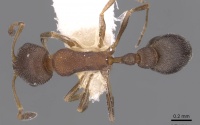Cardiocondyla luciae
| Cardiocondyla luciae | |
|---|---|

| |
| Scientific classification | |
| Kingdom: | Animalia |
| Phylum: | Arthropoda |
| Class: | Insecta |
| Order: | Hymenoptera |
| Family: | Formicidae |
| Subfamily: | Myrmicinae |
| Tribe: | Crematogastrini |
| Genus: | Cardiocondyla |
| Species: | C. luciae |
| Binomial name | |
| Cardiocondyla luciae Rigato, 2002 | |
Nothing is known about the biology of Cardiocondyla luciae.
Identification
This species is distinguished from all other Afrotropical Cardiocondyla for its combination of dark colour, shagreened gaster, slender body and nearly flat dorsum of the alitrunk. (Rigato 2002)
Keys including this Species
Distribution
Distribution based on Regional Taxon Lists
Afrotropical Region: United Republic of Tanzania.
Distribution based on AntMaps
Distribution based on AntWeb specimens
Check data from AntWeb
Countries Occupied
| Number of countries occupied by this species based on AntWiki Regional Taxon Lists. In general, fewer countries occupied indicates a narrower range, while more countries indicates a more widespread species. |

|
Estimated Abundance
| Relative abundance based on number of AntMaps records per species (this species within the purple bar). Fewer records (to the left) indicates a less abundant/encountered species while more records (to the right) indicates more abundant/encountered species. |

|
Biology
|
Castes
Only known from the worker caste.
Nomenclature
The following information is derived from Barry Bolton's Online Catalogue of the Ants of the World.
- luciae. Cardiocondyla luciae Rigato, 2002: 169, figs. 4, 5 (w.) TANZANIA.
- Type-material: holotype worker.
- Type-locality: Tanzania: Tarangire Nat. Park, Loborserit, xi.1998 (C. Polidori & L. Benaglio).
- Type-depository: MSNM.
- Distribution: Tanzania.
Unless otherwise noted the text for the remainder of this section is reported from the publication that includes the original description.
Description
Worker
Holotype. TL 2.1, HL 0.50, HW 0.39, CI 78, SL 0.35, SI 90, PW 0.26, AL 0.58.
A dark and slender species. In full face view head elongate, with almost parallel sides, clypeal lobe anteriorly straight, occiput notched in the middle. Maximum eye diameter 0.13 mm (14 ommatidia in the longest row). Scapes moderately long. With the alitrunk in profile the dorsal and anterior faces of the pronotum meeting at a distinct, blunt angle. Promesonotum almost flat, about at the same level of the weakly convex propodeal dorsum, metanotal groove wide and shallow. In dorsal view the pronotum has slightly angular humeri, and promesonotal sides clearly convergent toward the metanotal groove. Propodeum armed with two short teeth, wide at the base. Petiole in profile with a rounded domed node; in dorsal view the node appears somewhat drop-shaped and a little longer than wide; in posterior view its apex is blunt conical. Subpetiolar process poorly developed. In dorsal view, postpetiole nearly twice as wide as the petiole, a little wider than long and slightly narrower in front than behind.
Mandibles longitudinally striolate punctate, slightly shining. Dorsum of head shagreened, finely and regularly punctate; frons finely longitudinally striolate. Promesonotal dorsum shagreened and finely punctate, but with less distinct punctures. Sides of the alitrunk, propodeum and sides of the petiole mostly finely reticulate punctate. Dorsum of petiolar node and postpetiole shagreened; the former hardly shining. Gaster dorsally finely shagreened, matt and with a silky appearance.
Erect hairs present only on the anterior border of the clypeal lobe and at the tip of the gaster. Appressed pubescence well developed on the body and appendages, conspicuous on the head and especially on the gaster. On the first gastral tergite the pubescence is fairly abundant and a little denser than in C. longinoda (see above).
Colour reddish brown, gaster duller; antennae with a darkened club.
Type Material
Holotype worker: TANZANIA: Tarangire Nat. Park, Loborserit, xi-1998 (C. Polidori & L. Benaglio) Museo Civico di Storia Naturale, Milano.
Etymology
A noun in the genitive case; this species is dedicated to Lucia Benaglio who collected the single specimen described.

